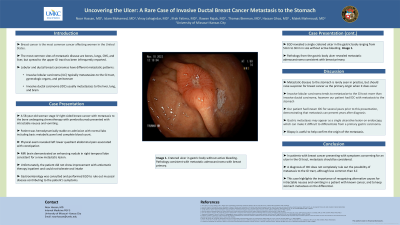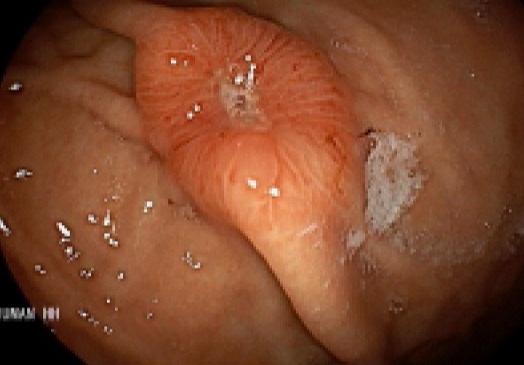Tuesday Poster Session
Category: Stomach
P4235 - Uncovering the Ulcer: A Rare Case of Invasive Ductal Breast Cancer Metastasis to the Stomach
Tuesday, October 24, 2023
10:30 AM - 4:00 PM PT
Location: Exhibit Hall

Has Audio

Noor Hassan, MD
University of Missouri-Kansas City
Kansas City, MO
Presenting Author(s)
Noor Hassan, MD1, Islam Mohamed, MD1, Vinay Jahagirdar, MD1, Ifrah Fatima, MD1, Rawan Rajab, MD2, Thomas Bierman, MD1, Hassan Ghoz, MD1, Malek Mahmoudi, MD1
1University of Missouri-Kansas City, Kansas City, MO; 2University of Missouri Kansas City, Kansas City, MO
Introduction: The most common carcinoma affecting women in the United States is breast cancer. Breast cancer can metastasize to various sites, however it has been reported that different subtypes have varying metastatic patterns. Invasive ductal carcinoma (IDC) affects the lung, bone, and liver while invasive lobular carcinoma (ILC) tends to metastasize to the gastrointestinal tract and peritoneum. We present an unusual case of IDC with metastasis to the stomach.
Case Description/Methods: A 58-year-old female with invasive ductal carcinoma of the breast with metastases to the bone on pembrolizumab chemotherapy presented to the hospital with intractable nausea and vomiting. The patient could not tolerate oral intake despite multiple antiemetic medications in the emergency room, and was therefore admitted. She was hemodynamically stable and labs were unremarkable. She underwent magnetic resonance imaging (MRI) of the brain which was significant for an enhancing nodule in the temporal lobe concerning for new metastasis, as well as lesions consistent with known osseous metastatic disease. Gastroenterology was consulted and performed upper endoscopy which revealed a single cratered ulcer in the gastric body ranging from 5 mm to 9 mm in size without active bleeding. Biopsy was taken from the gastric body ulcer. Pathology revealed metastatic adenocarcinoma consistent with breast primary. The patient's nausea and vomiting eventually improved and she was discharged in stable condition. She follows with oncology outpatient and continues on pembrolizumab chemotherapy.
Discussion: Metastatic disease to the stomach is rarely seen in practice, but should raise suspicion for breast cancer as the primary origin when it does occur. Specifically, ILC tends to metastasize to the gastrointestinal tract more than IDC. Our patient had a known IDC for several years prior to presentation, demonstrating that metastasis can present years after diagnosis. She had known metastasis to the bone, a typical site of spread for IDC, but also developed metastasis to the stomach– a rare complication. Gastric metastasis may appear as a single ulcerative lesion on endoscopy, which makes it difficult to differentiate from primary gastric carcinoma. Biopsy should be obtained to confirm the diagnosis. In patients with breast cancer presenting with symptoms concerning for an ulcer, metastasis should be considered even in IDC.

Disclosures:
Noor Hassan, MD1, Islam Mohamed, MD1, Vinay Jahagirdar, MD1, Ifrah Fatima, MD1, Rawan Rajab, MD2, Thomas Bierman, MD1, Hassan Ghoz, MD1, Malek Mahmoudi, MD1. P4235 - Uncovering the Ulcer: A Rare Case of Invasive Ductal Breast Cancer Metastasis to the Stomach, ACG 2023 Annual Scientific Meeting Abstracts. Vancouver, BC, Canada: American College of Gastroenterology.
1University of Missouri-Kansas City, Kansas City, MO; 2University of Missouri Kansas City, Kansas City, MO
Introduction: The most common carcinoma affecting women in the United States is breast cancer. Breast cancer can metastasize to various sites, however it has been reported that different subtypes have varying metastatic patterns. Invasive ductal carcinoma (IDC) affects the lung, bone, and liver while invasive lobular carcinoma (ILC) tends to metastasize to the gastrointestinal tract and peritoneum. We present an unusual case of IDC with metastasis to the stomach.
Case Description/Methods: A 58-year-old female with invasive ductal carcinoma of the breast with metastases to the bone on pembrolizumab chemotherapy presented to the hospital with intractable nausea and vomiting. The patient could not tolerate oral intake despite multiple antiemetic medications in the emergency room, and was therefore admitted. She was hemodynamically stable and labs were unremarkable. She underwent magnetic resonance imaging (MRI) of the brain which was significant for an enhancing nodule in the temporal lobe concerning for new metastasis, as well as lesions consistent with known osseous metastatic disease. Gastroenterology was consulted and performed upper endoscopy which revealed a single cratered ulcer in the gastric body ranging from 5 mm to 9 mm in size without active bleeding. Biopsy was taken from the gastric body ulcer. Pathology revealed metastatic adenocarcinoma consistent with breast primary. The patient's nausea and vomiting eventually improved and she was discharged in stable condition. She follows with oncology outpatient and continues on pembrolizumab chemotherapy.
Discussion: Metastatic disease to the stomach is rarely seen in practice, but should raise suspicion for breast cancer as the primary origin when it does occur. Specifically, ILC tends to metastasize to the gastrointestinal tract more than IDC. Our patient had a known IDC for several years prior to presentation, demonstrating that metastasis can present years after diagnosis. She had known metastasis to the bone, a typical site of spread for IDC, but also developed metastasis to the stomach– a rare complication. Gastric metastasis may appear as a single ulcerative lesion on endoscopy, which makes it difficult to differentiate from primary gastric carcinoma. Biopsy should be obtained to confirm the diagnosis. In patients with breast cancer presenting with symptoms concerning for an ulcer, metastasis should be considered even in IDC.

Figure:
Cratered ulcer in gastric body without active bleeding. Pathology consistent with metastatic adenocarcinoma with breast primary.
Cratered ulcer in gastric body without active bleeding. Pathology consistent with metastatic adenocarcinoma with breast primary.
Disclosures:
Noor Hassan indicated no relevant financial relationships.
Islam Mohamed indicated no relevant financial relationships.
Vinay Jahagirdar indicated no relevant financial relationships.
Ifrah Fatima indicated no relevant financial relationships.
Rawan Rajab indicated no relevant financial relationships.
Thomas Bierman indicated no relevant financial relationships.
Hassan Ghoz indicated no relevant financial relationships.
Malek Mahmoudi indicated no relevant financial relationships.
Noor Hassan, MD1, Islam Mohamed, MD1, Vinay Jahagirdar, MD1, Ifrah Fatima, MD1, Rawan Rajab, MD2, Thomas Bierman, MD1, Hassan Ghoz, MD1, Malek Mahmoudi, MD1. P4235 - Uncovering the Ulcer: A Rare Case of Invasive Ductal Breast Cancer Metastasis to the Stomach, ACG 2023 Annual Scientific Meeting Abstracts. Vancouver, BC, Canada: American College of Gastroenterology.

